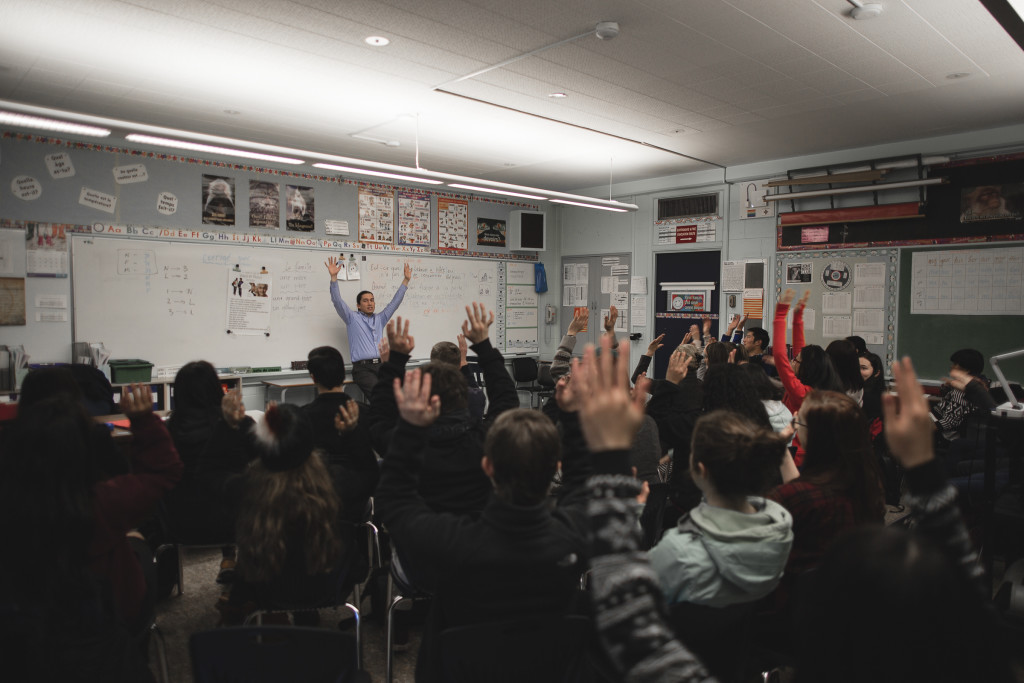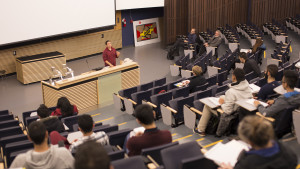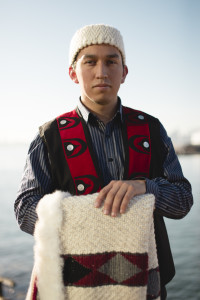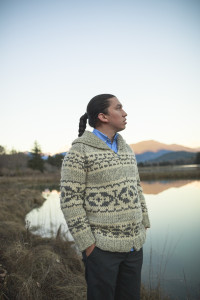With many Indigenous languages being listed as “critically endangered” as a result of having only a handful of fluent speakers left, it can seem like the one option left is to document these languages before they die out completely. Sort of like the linguistic version of freezing your body and being placed in storage, with the hope that some day in the future you can be thawed out, cured of all your ails, and released into more ideal conditions.
Rather than succumbing to such fatalism, which accepts language death now and only the faint hope of rebirth “one day”, some Indigenous youth are choosing to dedicate themselves to bringing their languages back into health in the present.
In the first of a series on language revitalization programs, here is an interview with 26 year old Khelsilem about his effort to radically increase the number of speakers of Sk̲wx̱wú7mesh sníchim.
-
What’s your elevator pitch? What’s the project, in 30 seconds or less?
The Temstl’í7 ta Sníchim Program is a full-time Sḵwx̱wú7mesh (Squamish) language immersion program that runs over two school years. Students attend from 9am-4pm Monday to Friday from September through April for approximately 1,000 immersion hours per year. Attendance is limited to fifteen participants. The objective of the program is to foster language skills in three areas: interpersonal communication, presentational speaking, and interpretive listening. Students who complete the program can become some of the most proficient second-language speakers of the Squamish Language.
-
How did you get SFU on board with this, and what does their support look like?
Simon Fraser University is the second largest university in Vancouver. The First Nations Language Centre at SFU, within the Department of Linguistics and Department of First Nations Studies, created the ‘First Nations Language Proficiency Certificate’ program. This program is a general language program focused on increasing a learner’s proficiency in a target language. They program has partnered with approximately 11 different Indigenous languages in BC and Yukon to offer university-accredited courses in various Indigenous languages.
Our organization, in partnership with SFU through the First Nations Language Centre, will work with this program. Whereas other communities have hosted the courses as 3-hour weekly classes, we’re taking the same program and implementing it on a full-time basis – meaning 4 courses in the fall semester and 5 courses in the winter semester for a total of 27 credits per year for students. One other adjustment our approach is taking is to teach courses previously or normally taught as English-medium courses; all 9 courses will be taught in the Squamish Language.
Here’s an example of the course topics:
- FNLG 130 – Practical Phonetics for First Nations Languages
- FNLG 133 – Introduction to First Nations Language I
- FNLG 134 – Introduction to FNLG II
- FNLG 158 – First Nations Language Immersion I
- FNLG 200 – Introduction to Grammar in a First Nations Language
- FNLG 233 – Description and Analysis of a First Nations Language I
- FNLG 234 – Description and Analysis of a First Nations Language II
- FNLG 258 – First Nations Language Immersion II
- FNLG 335 – Topics in First Nations Language I

Three hours of language instruction just doesn’t cut it, according to Khelsilem. Not if you want real fluency.
SFU’s involvement is fairly minimal at this point. Our organization is handling outreach, recruitment, curriculum development, and materials development. SFU provides space and salaries for the sessional instructors who will teach the course.
Students will primarily be First Nations members of the Squamish or Tsleil-Waututh Nation and utilize the Post-Secondary funding programs offered by each of these First Nations to cover the tuition fees, books, and materials, as well as a monthly living allowance.
The partnership is the beginning of what we hope can be an ongoing relationship that seeks to identify ways in which SFU can truly implement a policy of redress to the Indigenous peoples’ territory on which they’ve operated for decades.
-
Why are you focusing on adults?
Among the 4000 or so Squamish Peoples in the world, around 7 speakers exist who have a high level of proficiency in the language with a high level of fluency. Only about 5 of these speakers were raised with the language as their first language. Most of these speakers are over the age of 70.
If we use the Fishman 8-level Graded Intergenerational Disruption Scale (GIDS), the Squamish Language could be firmly classified as stradling stage 8 and 9 , where “(t)he only remaining speakers of the language are members of the grandparent generation or older who have little opportunity to use the language” and “(t)he language serves as a reminder of heritage identity for an ethnic community. No one has more than symbolic proficiency.” We could compare this to, for example, te reo Māori in Aotearoa (New Zealand) classified in different domains between stages 4 through 8.
In the same way colonialism’s strategy to eradicate our languages has been deliberate and strategic, so must we be in reclaiming them. Given our present state, our most useful response would be to focus on “(a)cquisition of the language by adults, who in effect act as language apprentices (recommended where most of the remaining speakers of the language are elderly and socially isolated from other speakers of the language).” To accomplish this, I’ve designed a program to increase the number of speakers in the child-bearing generation. The primary objective is to build the strength of language communities within the homes, fostering intergenerational transmission of the language, but we’re at such a low capacity in terms of the number of knowledgeable speakers that we must first offer a means to increase that number. That’s why we’re focusing on adults.
-
Will you be accepting non-Indigenous students, or students whose traditional language is not Squamish?
Our program guidelines state: “Applicants to this program must be Indigenous or parenting (or potentially parenting) children with Indigenous ancestry. Priority will be given to those with Squamish ancestry.” Basically, we are open to both non-Indigenous and non-Squamish participants. I’ll address the latter before the former.
We anticipate there will be significant interest in the approach we are taking – especially the immersion teaching methods we use and will find success with. But here’s the truth: the easiest way to learn ‘how’ we’re creating (Squamish) language speakers is to take our program and become a (Squamish) language speaker. I don’t have the time or ability to go to another language community, learn their language, create the curriculum and materials, and teach them how to run a full-time adult immersion program. The best I can offer is that they come and take our program and experience it directly, and then take the approach and modify it for their linguistic and cultural context.
We also anticipate there is the potential for mixed families who want to be a part of the movement to reclaim our language. Our principle is the Squamish Language belongs to the Squamish People and we should always be in control of it. However, we understand that in the 21st century many of young people are raising families with parents from other backgrounds and we know there will be parents in these family units who would be extremely interested in raising their children in our language. So we know this potential exists and we want to show we are supportive of this. If a non-Indigenous parent has it in their heart to become a speaker of our language so they and their partner can raise their children in our language, why would we deny such an opportunity to create a family unit with TWO parents speaking the language to their child?!
-
What do you want to see this program accomplish in the next 4 years? 10 years? What will graduates be doing?
The objective of our program is to increase the number of speakers of the Squamish Language. We differ from past attempts to increase the number of language speakers in that our goal is not to increase the number of language teachers. That goal is too limited. Our focus shouldn’t be to increase the number of teachers. Our goal should be to increase the number of homes speaking the language as their primary mode of communication, and raising their children with intergenerational language support. The need for more “teachers” will then arise naturally. Just like, eventually, the need for a language immersion daycare, a language immersion elementary school, and a language immersion secondary school will all flow from having the language rooted strongly in the homes first and foremost.

1000 instructional hours in Sk̲wx̱wú7mesh sníchim is a serious commitment that will pay off in more ways than one.
The simple goal of our program is to produce 15 highly proficient speakers each year. By 2027 (which will be the ten year anniversary of the program) we hope to have created at least 150 additional highly proficient speakers in the community. By 2037, we imagine this growing to 300 or more, all of whom will be primarily in the child-bearing generation producing children and hopefully raising those children in our language.
I also anticipate the graduates will find themselves highly employable as they become some of a very limited number of specialists in the Squamish Language. I also imagine some graduates using the knowledge gained to start their own businesses, such as a child-care centre or tutoring business for families seeking to increase their family knowledge of the language.
-
Two years of full-time immersion in the language is a lot. What the heck are you going to do every day, all day? Are you worried about running out of material to keep it motivating?
Our program activities centre on three main areas of focus: interpersonal communication, presentational speaking, and interpretive listening. The program is very carefully mapped out for Year 1 where we’ll operate on a two-week schedule structure. The program will follow this general structure:
Week 1:
A Block on Mondays and Wednesdays
B Block on Tuesdays and Thursdays.
C Block on Fridays.
Week 2:
B Block on Mondays and Wednesdays
A Block on Tuesdays and Thursdays.
C Block on Fridays.
A blocks will focus on interpersonal communication (conversation drills, back and forth dialogue, lessons on learning how to ask and answer all question forms). B blocks will focus on presentational speaking (announcements, invitations, presentations on a topic such as a landmark, person, or event). Interpretive listening activities will happen throughout. Fridays will be the most “fun” days, with more interesting or exciting activities scheduled on those days, such as guest speakers and group outings.
This will be our first year testing out the entire curriculum plan, so I imagine there will be adjustments as we go along but at this stage we know there’s a significant amount of grammar to cover and a significant amount of language skills that need to be practiced, trained, and mastered.
-
Are you going to focus first on orality, or literacy, or both? How will that be broken down over the program?
As with every language program, literacy in the language (if desired) should come after the student has acquired some language speaking skills and communicative ability. This is how many of us learned to successfully read and write English – years after learning to speak and communicate with it.
So literacy will be a focus at various points in the program, but very minimally and only to aid language learners by giving them a tool for note-taking and communication purposes.
-
What research did you do to come up with this program?
Five years I met Teyotsihstokwáthe Tekarihóken, Mohawk graduate who graduated from the Onkwawenna Kentyohkwa adult immersion Mohawk program in Six Nations, Ontario. She had explained to me how they create language speakers in the Mohawk nation with adult immersion programs in Six Nations, Kahnawake, and others. It was the first time I’ve heard of such an approach but it made sense. If you want to become an engineer, or an accountant, or a lawyer, there a programs that teach you the skills and knowledge to those professions. Yet, very often, there are no programs within the post-secondary institutions that focus on full-time language programs. And far too often, when language programs do exist within the universities, they are linguistics based programs, not immersion based programs. Linguistics is nice — if you want to learn how to talk about a language — but it won’t create highly proficient and fluent speakers.
When I traveled to New Zealand to meet with language educators and activists from the Maori community, they spoke of the same thing. “The first thing we did was get rid of the linguists” I heard. They were no help. They wanted to document the language instead of focusing on how to create more speakers. Bless their hearts, many linguists are trying and do want to help, but I think for many of our communities we’re realizing too late it’s the wrong tool for the problem we’re dealing with. My friend Suzanne from “Where Are Your Keys?” says it best: linguistics is like taxidermy when what we need is something more like nature preserves. I’m not interested in putting my dead language on a wall for future generations to talk about interesting it is that it has a “feminine and non-feminine pronoun structure” or how other Indigenous languages classify things into “animate and inanimate”.
The lead influences of my approach and the development of this program has been the work and advice of people such as the founder of Where Are Your Keys? Evan Gardner, socio-lingusit Joshua Fishman, Owennatekha from Six Nations, and Hana O’Regan from Kai Tahu in New Zealand. I especially recommend all language revitalization advocates read and study Joshua Fishman’s work, especially his books Reversing language Shift: Theory and Practice of Assistance to Threatened Languages, Can Threatened Languages Be Saved?, and Do Not Leave Your Language Alone: The Hidden Status Agendas Within Corpus Planning in Language Policy. The Fishman approach is something every director of a language program needs to understand and implement in my opinion.
-
Do you have any applicants? Do you worry about filling all the spots in the class?
As of right now we have around 24 potential applicants for only 15 spots. This was a similar case for the Mohawk adult immersion programs. They have waitlists for their programs because the demand is so high.
-
Do you have fears about students leaving part way through the program?
We think there is always the potential for students to drop-out part way through due to various reasons, but we are specifically asking all who are chosen to be a part of the program to seriously commit. We will be stressing this is an opportunity not available to everyone and that they were carefully selected for the program.
-
What do you think are the main obstacles to this program being a success?
Sometimes the biggest obstacle for success is our own people. Maybe I worry too much about power-hungry or ego-driven people out there who will jump at a chance to sabotage others’ successes because they are jealous, or not in control, or lacking self-esteem. It happens a lot in our Indigenous communities when people try to break the status-quo or push back against complacency.
However, I keep thinking about the words of Maori language activist Hana O’Regan when she says “Our language was deliberately stripped from us. We need to be just as deliberate about getting it back!”
From where I stand, I have one outlook of where we are at currently, I have a vision for where we can go, and I have a strategy for getting us there. If anyone has other ideas, I’m happy to hear them. But doing nothing is the only way we can kill our languages.
-
What do you think are the reasons this program WILL succeed?
The young people in my community crave their heritage and language. Many now understand that they don’t have this thing because it was deliberately made that way. And they want it for themselves for all kinds of reasons.
But we also know no one is going to become a language speaker form 2-3 hours of instruction per week. If you want fluent speakers, you do immersion. Plain and simple. And if you’re not increasing the number of language speakers in your language community, you’re not saving your language. You’re hospicing it. Not death with a bang, but with a slow silent lonely whimper.
I believe this program will succeed because none of this would be possible without the foresight and diligence of those who came before me. This program can only exist because others laid the path for us and we’re just walking it finally. I believe we will succeed because my people will see us taking our power back, and people will be clamoring to be a part of that.
And not only that, others from other peoples will take notice and want to join in too.
-
How do you say “Métis In Space” in Squamish?
This is funny. We have such a Sḵwx̱wú7mesh-centric view of the world. Our word for all Indigenous peoples east of the Rocky Mountains is Lheḵetá. So I’m told Métis In Space could be said like: Na wa huyá7wit ti ḵ’eḵ’sin̓ ti siyát-shen tkwetsi lhek’éta.
Don’t laugh. I’m serious! Haha.
The phrase is literally saying “The Metis have left this world”.





8 Comments
ᎬᎵ ᎦᏈᎵᎡᎴ · March 20, 2016 at 3:50 am
Wonderful article. It breaks my heart to know about all these endangered languages, and it fills me with anger to know how these languages were made endangered in the first place. I’m not Native (in fact, I’m Italian), but I strongly support you. I myself have been studying a bit of Lakota.
yardarm51 · March 20, 2016 at 11:42 am
I was one of the people who helped Khelsilem crowdfund the Language House project a little way back so I am incredibly happy to see the scope of his efforts grow. I still proudly wear my Sḵwx̱wú7mesh Highway t-shirt and have received a number of really positive comments on it from my fellow social studies teachers and our students.
The CBC Aboriginal article you have linked Khelsilem states “A couple ofpost [sic] community members have indicated their boss would give them a year leave of absence to take the program…” This is fantastic, and I would hope a good sign that there are more employers out there who would encourage their young workers to take an opportunity like this.
Frederick Peitzsche · March 20, 2016 at 12:16 pm
Most worthwhile initiative, I’ve seen in any school system in years, a real tragedy if any language is ‘lost’, we call snow just snow but the Inuit have several different words for snow that describes what kind of snow it is.
âpihtawikosisân · March 20, 2016 at 7:55 pm
Ehhhh, not exactlly. You can describe snow in English in many different ways, so can the Inuit. It just happens that Inuktitut (like Cree and many other Indigenous languages) express these descriptions in long, single words rather than saying “wet, heavy snow” and so on.
ᎬᎵ ᎦᏈᎵᎡᎴ · March 21, 2016 at 2:26 am
Yeah, since Inuktitut is a polysynthetic language, as Cree and many other. In fact, almost anything can be expressed in long single words in these languages.
I don’t think Inuktitut is endangered, though, but I could be wrong…
âpihtawikosisân · March 21, 2016 at 7:21 am
Not endangered, definitely, but in decline like all our languages, unfortunately.
I had to address the myth about the Inuit having tonnes of words for snow though. I teach Inuit youth, and every once in a while we discuss myths about Inuit. This is one they were really confused about, because it’s something they can immediately verify is untrue. They have one word for snow, and then many different ways of describing snow; which is something we can do in English as well. The concept is often brought up as a way of proving one’s natural environment influences language, which I do actually believe to be true…it’s just that this particular example is a very poor, and inaccurate one.
ᎬᎵ ᎦᏈᎵᎡᎴ · March 21, 2016 at 8:23 am
I didn’t know Inuktitut was declining, and that’s really, really bad. And it’s worse to think that this is not a language in bad conditions, compared to other Native American languages…
That’s why I find these kind of projects really admirable.
Michael Black · April 3, 2016 at 11:13 am
I think it’s trying to convey a concept, but fails by trying to simplify it.
Words in themselves don’t matter, the things which surround us are common to different people.
It’s the structure of a language that reveals the culture. I may not even be using the right words here. Since most people equate words with language, telling them that “there are lots of words for snow” lets them know that snow must be important (which actually seems pretty obvious) to the people. But it’s the structure that gives insight. I can learn some Syilx words, and it won’t tell me anything about the culture.
This is especially so now, when in order for a language to be used, current things have to be added, like cellphones. That won’t give me insight into people’s lives 200 years ago.
But how those things are incorporated may say something, and actually learning the language will.
One of the ironies of all those westerns is the indians speaking broken English, which makes them look “simple”. Never mind that they did learn some English, or that others became quite capable in English soon after contact (Spokan Gary went East from the Pacific Northwest in 1824 when he’d only have had contact with some fur traders, yet didn’t seem to have trouble learning English).
But climbing into their minds via learning the language well (not just a broken language where they’d know some words) surely showed people who actually could put two thoughts together.
Michael